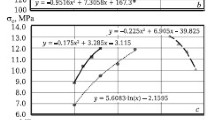Abstract
A shrinking undegraded core and a porous outer layer result, if the organic vehicle used for shaping ceramic or metal powder mouldings recedes in the interparticle space of the moulded body during pyrolysis. In the present work, a numerical model has been used which simulates the undegraded shrinking core situation and quantifies degradation of the organic vehicle and the diffusion of the resulting products in solution in the organic phase during pyrolysis of a ceramic moulding. This model is extended to include gaseous mass transport in the porous outer layer for a moulding in the shape of an infinite cylinder. The effect of resistance to gaseous mass transport in the porous outer region on defects originating in inner regions was estimated. It is shown that the greatest obstruction to mass transport is diffusion of degradation products in solution in the organic phase. However, the permeability coefficient for gas transport in the outer region begins to affect the critical heating rate required for avoidance of defects only when it is less than 10−15m2.
Similar content being viewed by others
Abbreviations
- C :
-
Concentration,C=C (r, t), based on the total volume of ceramic suspension
- d :
-
Effective molecular diameter of alphamethylstyrene
- D :
-
Diffusion coefficient,D=D (C, T)
- e :
-
Porosity of powder
- E :
-
Activation energy for thermal degradation
- h :
-
Remaining weight fraction of polymer
- ΔHvap :
-
Enthalphy of vaporization
- i :
-
Node number
- I :
-
Pre-exponential constant in Equation 13
- j :
-
Time step
- K p :
-
Permeability coefficient
- K 0 :
-
Specific rate constant
- m :
-
Mass of monomer displaced
- M :
-
Mass of one alphamethylstyrene molecule
- P :
-
Monomer vapour pressure
- P s :
-
Monomer vapour pressure at outer surface of the cylinder
- P 01 :
-
Vapour pressure of monomer over its pure liquid
- Q :
-
Rate of production of monomer, based on the total volume of ceramic suspension
- r :
-
Radius of the cylinder
- r j :
-
Distance from central axis to the inner surface of the porous layer at time stepj
- r 0 :
-
Initial radius of the cylinder
- R :
-
Universal gas constant
- S 0 :
-
Specific surface area of powder per unit solid volume
- t :
-
Time
- T :
-
Absolute temperature
- T c :
-
Temperature at maximum vapour pressure of monomer and atZ c
- V :
-
Volume of monomer
- V c :
-
Ceramic volume fraction
- V p :
-
Polymer volume fraction
- w :
-
Mass of monomer stored in the porous annulus
- Z :
-
Heating rate
- Z c :
-
Critical heating rate
- θ1 :
-
Volume fraction of monomer in the polymer-monomer solution
- η:
-
Viscosity of the monomer vapour
- ρp :
-
Density of the polymer
- χ:
-
Polymer-monomer interaction constant
References
M. J. Edirisinghe andJ. R. G. Evans,Int. J. High Tech. Ceram. 2 (1986) 1.
Idem. ibid. 2 (1986) 249.
J. R. G. Evans, in “New Materials and their Applications”, edited by D. Holland (Institute of Physics, Bristol UK, 1990) pp. 25–32.
J. R. G. Evans andM. J. Edirisinghe,J. Mater. Sci. 26 (1991) 2081.
M. R. Barone andJ.C. Ulicny,J. Amer. Ceram. Soc. 73 (1990) 3323.
G. C. Stangle andI.A. Aksay,Chem. Eng. Sci. 45 (1990) 1719.
D. S. Tsai,A. I. Ch. E. J. 37 (1991) 547.
R. M. German,Int. J. Powder Metall. 23 (1987) 237.
P. Calvert andM. Cima,J. Am. Ceram. Soc. 73 (1990) 575.
J. R. G. Evans, M. J. Edirisinghe, J. K. Wright andJ. Crank,Proc. R. Soc. Land. A432 (1991) 321.
S. A. Matar, M. J. Edirisinghe, J. R. G. Evans andE. H. Twizell,J. Mater. Res 8 (1993) 617.
J. L. Duda, J. S. Vrentas, S. T. Ju andH. T. Liu,A. I. Ch. E. J. 28 (1982) 279
A. E. Scheidegger, “The Physics of Flow High Porous Media” 3rd Edn (University of Toronto Press, 1974) pp 100–1.
Y. Bao andJ. R. G. Evans,J. Eur. Ceram. Soc. 8 (1991) 81.
G. A. Birch, “Molecular Gas Dynamics” (Clarendon Press, Oxford, 1976) pp. 73–75.
A. Bondi andD. J. Simkin,A. I. Ch. E. J. 6 (1960) 191.
R. N. Maddox andA. L. Hines, “Mass Transfer Fundamentals and Applications” (Prentice-Hall, Englewood-Cliffs, NJ, 1985) p. 151.
E. H. Twizell, “Computational Methods for Partial Differential Equations” (Ellis Horwood, Chichester, UK, 1984) pp. 10, 11.
P. C. Carman,J. Soc. Chem. Ind. 57 (1938) 225.
J. S. Reed,J. Am. Ceram. Soc. 76 (1993) 547.
N. Wakao, S. Otani andJ. M. Smith,A. I. Ch. E. J. 11 (1965) 435.
R. M. Barrer, in “The Solid-Gas Interface”, edited by E. A. Flood, Vol. 2 (Marcel Dekker, New York, 1967) pp. 557–609
D. S. Scott andF. A. L. Dullien,A. I. Ch. E. J. 8 (1962) 113.
Author information
Authors and Affiliations
Rights and permissions
About this article
Cite this article
Matar, S.A., Edirisinghe, M.J., Evans, J.R.G. et al. Modelling the removal of organic vehicle from ceramic or metal mouldings: The effect of gas permeation on the incidence of defects. J Mater Sci 30, 3805–3810 (1995). https://doi.org/10.1007/BF01153938
Received:
Accepted:
Issue Date:
DOI: https://doi.org/10.1007/BF01153938




